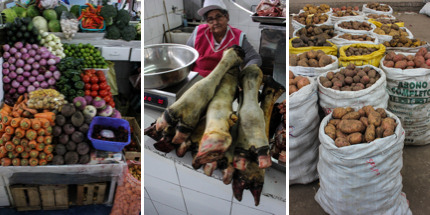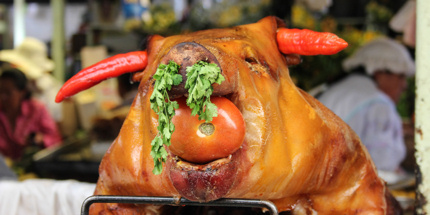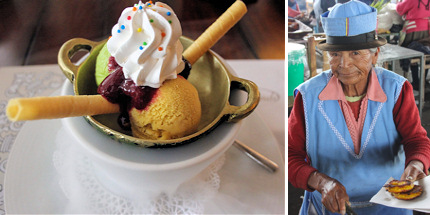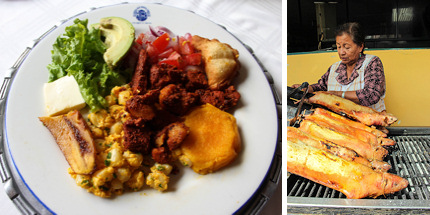An epicurean feast through Ecuador
Any chef worth their salt will tell you the key to good food is fresh produce – and Ecuador has plenty of that. Its mountainous haciendas and tropical plantations offer rich pickings for gourmets, who are reinventing Ecuadorian cuisine and establishing this small nation as the gastro capital of South America. Gavin Haines grabs a fork.
Culinary curiosities and food markets
I went to dinner with someone recently who, when asked by the waiter how he liked his steak, replied rather crudely: “Wipe the cow’s a**e and cut off its hooves.” If the bloodthirsty diner in question was slightly curious as to where such hooves might end up – and I suspect he isn’t – I could point him in the direction of Quito’s San Francisco market.
Established in 1893, as well as being stacked to the rafters with fresh fruit and vegetables, it does a line in curious cuts of meat, including the aforementioned trotters. “We use them to make cow feet soup,” explains my guide David Carrion. “We eat it at the weekend – it’s good for hangovers.” Suffice it to say, the Ecuadorians let nothing go to waste; other delicacies for sale here include sheep eyes, cow’s stomach (commonly served with rice, boiled egg and peanut sauce) and calf foetuses, which I’m told make a mean broth.
 Find the freshest produce (including trotters) at markets
Find the freshest produce (including trotters) at marketsAlthough not for the fainthearted, Ecuador’s food markets are amongst the finest I have experienced. There’s a sense of occasion about visiting them. They are the beating heart of communities, a place where people gather not only to trade groceries, but to catch up with friends over food, drinks and live music. Otavalo is the big one. Located in the verdant Andean highlands, a couple of hours from Quito, it’s the largest Indian market in Latin America and is the place to buy souvenirs in Ecuador.
In addition to ubiquitous handicraft stalls, Otavalo is home to a magnificent food court, which is perfect for sampling true Ecuadorian cuisine (foetus and all). Veggies are spoilt for choice too – there are soups, pulses, perfectly ripened fruits and more variety of potatoes than I knew existed.
The land of plenty
Ecuador’s beautiful capital, Quito, was the first city – along with Krakow – to be declared a World Heritage Site by UNESCO. It’s regarded as the best-preserved colonial city in South America, which is impressive not least because it also happens to sit in the middle of the “Avenue of Volcanoes.”
 Pork is a favourite dish
Pork is a favourite dishGavin Haines
There are constant eruptions here and geologists predict a big one is imminent, which would devastate Quito. On the flipside, this volcanic activity makes for fertile soil, which Andean farmers claim is the key to their ambrosial produce. Ecuador’s landscape influences its cuisine in other ways, too; the mountainous interior provides a cool, rainy climate which makes the Andean countryside look more like Wales than the tropics. It’s perfect for farming.
But descend the mountains and the equatorial climate hits you, which is ideal for cultivating exotic fruits, vegetables and cocoa (Ecuador produces fine chocolate). Seafood abounds too, particularly shrimp which is farmed along the coast at great expense to the country’s mangrove forests.
National dishes
It is the coastal regions that set the culinary tone for Ecuador; seafood is the main ingredient in the national dish, ceviche. There are many variations, but Ecuadorian ceviche is served as a cold, citrusy soup with shrimp, octopus, fish, tomato and red onion. It often comes with a side of chulpi (roasted Andean corn) and chifles (deep-fried plantain chips). I tried it at Café Plaza Grande, a fabulous baroque restaurant in old town Quito. Their ceviche is exquisite, although the best thing about dining here is the way they serve ice cream; I’m not going to spoil the surprise, but it involves cloaked men and dry ice. But back to soup, because Ecuadorians love the stuff. Locro de Papa seems to be the most popular one, and from what I gather it’s made entirely of cheese and potato – heavy stuff but it tastes great and seems to ease my altitude sickness.
 Indulge in tasty ice cream or sample traditional corn fritters
Indulge in tasty ice cream or sample traditional corn frittersGavin Haines
Reinventing Ecuadorian cuisine
Ecuador has other culinary specialities, roast guinea pig being one of them. You can buy el cuy on the streets, where you’ll see them being spit-roasted on a barbecue, or order them in a fancy restaurant like I did; La Gloria does great guinea pig and keeps a fine wine cellar. Roast pork is another Ecuadorian staple and so is quinoa, a versatile Andean grain lauded for its health benefits. It’s perfect for diners pursuing a meat-free diet and goes well with the cheesy, mashed potato patties they call llapingachos.
Although markets are perfect for quaffing authentic Ecuadorian cuisine, Quito has fine restaurants that are bringing a contemporary twist to time-honoured recipes. Achiote and La Choza are two of them and have become culinary reference points in the capital with their gourmet cuisine and local wines.
 Guinea pigs, chulpi and plantain are Ecuadorian delicacies
Guinea pigs, chulpi and plantain are Ecuadorian delicaciesGavin Haines
“We’re searching Ecuador for lost recipes and ingredients that aren’t being used anymore,” says Lucy Groner, head chef at Achiote. “We are a country that is rich in produce and we are being more innovative and smart with it.”
-------------------------------------------------------------------------------------
NEED TO KNOW
When to go: In the highlands you can experience all the seasons in one day, so expect sun and rain whenever you visit. June to September is generally warmer and drier, though. The rainforest is wet and warm all year, while the coast has more clearly defined seasons; May to November is dry and warm, December to April is wet and warm.
Getting there: There are no direct flights to Quito from London, but KLM (www.klm.com) flies via Amsterdam.
Getting around: A historic train line (wwww.trenecuador.com) linking Quito with the coast reopened this month. It is the most scenic way to see Ecuador and takes passengers along the infamous Devil’s Nose section, which is regarded as the most challenging stretch of railway in the world. Otherwise, traffic-congested Quito is best explored on foot, ideally with a guide (www.metropolitan-touring.com).
Where to stay: La Ronda is an enchanting, cobbled street, home to lively bars, buskers and traditional craftspeople, who ply their trade in anything from piano repairs to hat making. At the heart of this is the beautiful boutique hotel, Casona de la Ronda, which is dangerously close to a chocolatier.
Where (else) to eat: Zazu serves five-star international cuisine in sumptuous surroundings, while chefs at Alma cook exquisite Argentinian fare. For a taste of neighbouring Peru, drop by at Lua.
If you liked this article, you may also like:
A foodie's guide to Japan
Review: Balthazar restaurant, London
Top 5: Afternoon teas in England
Do you have any Feedback about this page?
© 2025 Columbus Travel Media Ltd. All rights reserved. No part of this site may be reproduced without our written permission, click here for information on Columbus Content Solutions.









 You know where
You know where